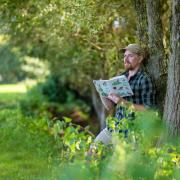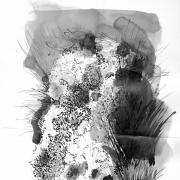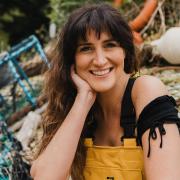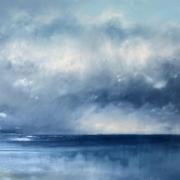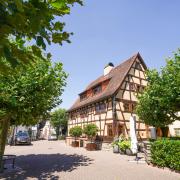Joe Banks meets a maker creating special pieces from items found on the water’s edge

Barney Dearsly has always felt a strong connection to the water. He grew up beside the Exe estuary in Lympstone and as a teenager quickly developed into a highly-accomplished yachtsman.
By the time he was 17 he’d moved on from messing about on the estuary to representing Great Britain in two-man catamarans, travelling as far as New Caledonia in the South Pacific to take part in world championships.
His other passion from an early age kept him rooted to home. Foraging on the estuary shore for interestingly shaped driftwood and all the other flotsam and jetsam that gets left behind by the tides was an equally compelling, but very different, way of connecting to his locale. These days, Barney still sails competitively at the weekend, but it’s the beach finds that have become the central focus of his life through his business, Weathered By Water.
Barney explains: “There’s always that sense of wonder with found objects – how they’ve been shaped and their history.”
His fascination with beachcombing can be traced back to childhood walks with his family: “My parents used to have a little game on beaches with different coloured bits of sea glass. Due to weathering, and longshore drift and erosion, a bit of glass from an old beer bottle will end up completely smooth. Emeralds would be worth a penny, a rupee would be worth 3p and sapphires would be worth 5p. And they had to be dead smooth. If they had a sharp edge Dad would discard them. You’d end up with enough money to buy an ice-cream, maybe.”
Gazing down at mud, sand and shingle in the hope of finding something magical became a bit of an obsession. A natural maker, Barney was soon turning his finds, already transfigured by salt water and UV bleaching, into bookshelves, mirrors and other objects. Giant cotton reels found washed up on the coast at Beer were turned into attractive lamps, a 250-year-old trunk of elm became a driftwood picture frame. It wasn’t long before these creations started to sell to friends and at local art fairs.

It was while working at a major picture framers in London, that Barney discovered mudlarking on the Thames foreshore. “I had a friend in the metalwork department who worked with found metal and we just decided one day to go down to the Thames scouring for metal, wood, found objects. We kept finding amazing pieces so we just kept going down. We’d cycle all the way back through central London with them - drawing a few interesting looks along the way!”
One of his favourite pieces from this period is a sculpture containing hundreds of clay tobacco pipes, which look, he says, “alive or flowing, kind of organic”. It’s this vitalising effect of nature on man-made things, he says, that makes objects shaped by time and the elements so beautiful and compelling.
The wealth of material he gathered in London reignited his passion for foraging and inspired Barney to turn his old hobby into a serious business when he returned to the West Country in 2011. He honed his carpentry skills further by training at Rowden Atelier woodworking school under renowned furniture maker David Savage.
As well as the unadorned found objects, simply (though inventively) repurposed, Weathered By Water now sells highly-finished items such as glass-topped coffee-tables displaying sea bricks from the Exmoor coast. They combine the warm, rugged qualities of these finds with first-rate craftsmanship to produce very stylish and characterful pieces of furniture that are finding an ever-growing audience.
Back on his home turf, Barney is still often found roaming his favourite stretches of Devon’s coasts and rivers searching for new materials, but much of his time over the last year has been spent within the industrial confines of a fabricating yard at Exeter quay. It’s here he’s just completed his most ambitious and striking creation to date, the ultimate bit of marine debris: a four-metre high ‘boat pod’ fashioned from the upturned bow section of a wooden trawler.
The Anthony Stevenson was a retired fishing vessel built in 1945 that worked out of Newlyn harbour in Cornwall. Having come to the end of its working life it was passed onto Julie and Brian Pogson at Exeter Maritime Services to be decommissioned. But rather than go through the usual decommissioning process that would see it end up in landfill, they wondered if these beautifully built, historic vessels could be repurposed in some way. Having been shown Barney’s work they invited him down to Gabriel’s Wharf and asked if he might have a use for them. He jumped at the chance.
“When I went down there I was just blown away by the scale, the textures and the colours of these boats. Pieces I could never dream of getting off a beach were sat there, smack bang in the yard, ready for me to use. I couldn’t believe the opportunity.”
He saw the possibility, he says, “to make a statement piece, something that will last another sixty years. To work with these materials is amazing.”
Transforming this wreck into a delightful living space has been hard graft. Two tonnes of concrete ballast had to be removed from the interior which was then shotblasted clean. The exterior was covered in fibreglass to make it watertight, painted, and now proudly bears its reinstated Penzance port name and number, PZ331. An engineered oak floor has been laid and electrics wired.
A bespoke wood-burning stove sits at the back of the pod, ingeniously welded from an old mast step that was lying about in the yard, and, after being re-sprayed, has been finished off with a similarly “re-loved” brass port-hole cover. A large circular doorway made with aluminium trim can be zipped closed with sail canvas provided by a local sailmaker.
The result is a wonderfully cosy and uniquely atmospheric room shaped by the original massive, curved planks of larch and ribs of oak, and it can be adapted to a plethora of uses: a retreat, a children’s den, an artist’s studio, a writer’s room, a personal library, somewhere to sleep out.
“It’s a special place to relax, a hideaway. Protected from all the elements,” says Barney. “It was built to withstand Atlantic swells; it’s been fishing down in the Bay of Biscay and up in the North Sea. You can almost sense the journeys it’s been on, the places it’s been to.”
Once he’s found a home for the pod, Barney has plans for the many other derelict boats that lie piled up at the boatyard, with a view to creating even grander structures. Battered by the elements they may be, but with Barney’s craftsmanship and imagination behind them, these old worthies of the sea look set for an interesting second life.
Barney’s Top Five Favourite Finds
1. An old keel section - found on the River Exe and turned into a striking bench that seats awaiting customers at Lympstone Fish Store.
2. Sea bricks – these warm and textured objects feel alive to the touch and when grouped together play magic with the eye.
3. Large fossils - these large ammonites are perfectly preserved in hard bedrock.
4. A large section of purple heart wood, once a keel runner – this made an amazing mirror. Now brown in colour, when freshly cut the wood is a striking purple.
5. Whale ambergris – a very rare waxy substance excreted by sperm whales, highly valuable. I didn’t know what it was and left it on the beach!
Barney’s Top Five Beachcombing Spots
1. River Exe - great for finding all manner of industrial bits of metal and hardwood driftwood at high and low tide.
2. The River Thames by the City, London - such a heavily used river over such a long time, there are lots of wonderful things to find. Just a couple of steps and you’ll find clay pipes, old glass bottles and lots of pieces of oak.
3. Lyme Regis - great for fossil-hunting and driftwood.
4. Weston - great for driftwood and all manner of objects still turning up off past ship wrecks.
5. Gravesend - an old Victorian dump. Amazing finds from glass beads to old bottles.






